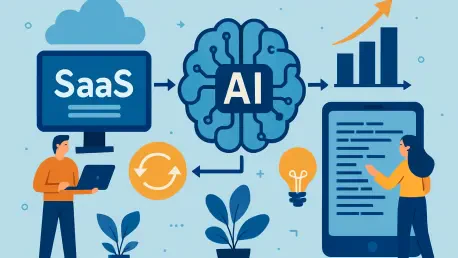Imagine a business landscape where enterprises function with the precision and scalability of software companies, leveraging artificial intelligence (AI) and cutting-edge digital tools to overhaul traditional workflows. This transformative vision, known as service-as-software, is poised to redefine how organizations operate in an era of rapid technological advancement. Far from a mere incremental upgrade, this model proposes a radical shift, integrating data, processes, and expertise into a seamless digital framework that promises unprecedented efficiency and adaptability. As AI and agentic technologies continue to mature, companies stand at the threshold of a paradigm shift that could shape competitive dynamics for decades. This concept extends beyond the familiar territory of software delivery, envisioning a unified system where every facet of a business is orchestrated with software-like precision. Exploring this emerging model reveals profound implications for technology architectures, operational strategies, and business frameworks across diverse industries. The journey into service-as-software unveils a future where siloed operations dissolve, replaced by integrated platforms that empower organizations to respond to challenges with agility and insight.
Redefining Technology Through Unified Platforms
The evolution of software delivery has been a cornerstone of business transformation, transitioning from cumbersome on-premises systems to the flexible, subscription-based software-as-a-service (SaaS) model that dominates today. Service-as-software builds on this legacy, pushing the boundaries further by influencing not just IT departments but the entire organizational structure. At the heart of this shift lies the concept of a “System of Intelligence” (SoI), a centralized platform designed to integrate data and application logic across all business domains. This unified system enables AI agents to interact with legacy infrastructure, dismantling the silos that have long hindered cross-functional collaboration. The promise of SoI is a comprehensive, real-time perspective of business operations, often described as a “four-dimensional” view. This means understanding past events, analyzing their causes, predicting future outcomes, and determining actionable steps—all within a cohesive digital environment. Such a framework contrasts sharply with current limitations, where gleaning insights across departments like marketing and sales often demands extensive manual data engineering. For enterprises, adopting this technology signals a move toward agility, where decisions are informed by a holistic understanding of the business landscape rather than fragmented data points.
Beyond breaking down silos, the technological implications of service-as-software extend to redefining how companies approach innovation and scalability. The integration offered by SoI allows for seamless updates and enhancements, ensuring that businesses remain adaptable in a fast-paced digital economy. Unlike traditional systems that require significant overhauls to incorporate new functionalities, this model supports continuous improvement through AI-driven insights and automated processes. Moreover, the ability of AI agents to interface with older systems means that organizations do not need to discard existing investments entirely but can instead enhance them within a modernized framework. This approach minimizes disruption while maximizing the value derived from both new and legacy technologies. As industries grapple with increasing complexity, the unified platform serves as a strategic asset, enabling firms to navigate challenges with data-driven precision. The shift to such an architecture is not without hurdles, particularly in harmonizing disparate data sources, yet the potential to unlock deeper insights and streamline operations makes it a compelling direction for forward-thinking enterprises.
Revolutionizing Operations with Agentic Workflows
Operationally, service-as-software introduces a transformative vision by moving away from isolated pockets of automation toward what can be described as a “build-to-order assembly line” for knowledge work. This innovative approach merges the efficiency of high-volume production with the tailored precision of advisory services, fundamentally altering how tasks are executed within organizations. Rather than relying on disjointed automated processes that address only specific functions, this model orchestrates workflows digitally, ensuring that each step is aligned with overarching business goals. AI agents play a central role, functioning as digital consultants under the supervision of human managers who prioritize strategic oversight over routine task management. This structure allows for a dynamic workflow where technology handles repetitive activities, freeing up human talent to focus on complex problem-solving and innovation. The result is an operational framework that not only boosts productivity but also adapts to unique business needs with remarkable flexibility, akin to how bespoke services operate in sectors like consulting.
As this operational model matures, a significant shift occurs in how expertise is captured and utilized within enterprises. Over time, human knowledge and decision-making patterns are encoded into AI agents, reducing the dependency on manual intervention and significantly expanding organizational capacity. Managers transition into roles where they oversee vast swarms of these agents, directing efforts toward amplifying expertise rather than merely enhancing efficiency metrics. This redefinition of managerial responsibility emphasizes the return on intellectual capital, focusing on how effectively human insights can be scaled through digital means. The operational blueprint under service-as-software thus fosters a continuous learning environment, where each interaction refines the system’s capabilities, much like advanced technologies in other fields improve through iterative feedback. While challenges remain in standardizing knowledge work without losing the nuance of human judgment, the potential to create a scalable, customized operational engine positions this model as a game-changer for industries aiming to balance efficiency with innovation.
Transforming Business Models with Platform Economics
At the core of service-as-software lies a profound transformation in business models, shifting from traditional labor-intensive economics to a platform-driven approach powered by digitally encoded expertise. Unlike conventional setups where costs escalate with increased headcount, this model leverages AI and data to achieve scalability with declining marginal expenses. Consider the example of a law firm reimagined as a software platform: legal expertise is progressively captured by agents, enabling a transition from hourly billing to fixed-fee structures. This not only streamlines cost structures but also enhances client value by delivering consistent, high-quality outcomes at predictable prices. Such a shift creates a competitive edge, as firms can serve more clients without proportional increases in resources. The broader implication is a move toward platform economics, where the value of services grows through data network effects and learning curves, positioning early adopters to dominate their markets with unparalleled efficiency.
This transformation extends far beyond legal services, impacting any industry reliant on knowledge work, including manufacturing and professional services. The winner-take-most dynamic emerges as a critical factor, where companies that embrace service-as-software early gain significant advantages through accumulated data and refined agent capabilities. As these organizations scale, their systems become more adept, further widening the gap between leaders and laggards. This trend challenges traditional business thinking, urging firms to view data and AI as primary drivers of production rather than mere tools. However, navigating this shift requires rethinking pricing strategies and cost structures, as the economics of agentic capabilities introduce new variables like compute expenses and data curation. The potential for industries to redefine competitive landscapes through platform economics is immense, yet it demands strategic foresight to balance innovation with sustainable profitability in a rapidly evolving digital arena.
Navigating Governance and Security Imperatives
As enterprises adopt service-as-software, the importance of governance and security escalates, particularly in heavily regulated sectors such as healthcare and finance. The deployment of AI agents necessitates dynamically enforced policies that extend beyond traditional API oversight to manage the intent and actions of these digital entities. Ensuring compliance with stringent regulations becomes a first-class priority, as businesses must address complex issues like data locality, retention, and lineage. The ability to explain agent-driven decisions over extended periods—often spanning several years in industries with long audit cycles—emerges as a critical requirement. This heightened focus on governance reflects a broader trend toward policy-driven IT environments, where access and behavior are managed in real time, sometimes even generated dynamically by AI systems themselves. For companies, this means investing in robust frameworks that safeguard operations while maintaining the flexibility to innovate within regulatory boundaries.
Equally vital is the role of strategic partnerships with infrastructure providers who possess deep expertise in navigating regulatory landscapes across jurisdictions. These collaborations are essential for managing the complexities of data compliance, especially as the scale of AI deployment grows. The risks of non-compliance are not merely operational but can pose existential threats to businesses, particularly in sectors where breaches or missteps attract severe penalties. Beyond regulatory challenges, security concerns intensify with the integration of vast data sets and agentic systems, requiring continuous monitoring to prevent unauthorized actions or data exposures. The emphasis on governance and security as foundational elements rather than afterthoughts aligns with industry consensus on the need to balance technological advancement with risk management. Enterprises venturing into this model must prioritize these imperatives to ensure trust and stability, recognizing that successful adoption hinges on safeguarding both data and decision-making processes in an increasingly autonomous digital ecosystem.
Harnessing Edge Computing and Digital Twins for Strategic Advantage
Edge computing is rapidly emerging as a transformative force within the service-as-software paradigm, positioning itself as a new kind of data center where devices at the periphery continuously feed real-time insights back to central systems. This feedback loop refines best practices by grounding them in actual field conditions rather than theoretical models, enabling businesses to adapt swiftly to dynamic environments. Managerial roles evolve significantly in this context, as leaders integrate edge-sourced signals with institutional knowledge to drive informed decision-making. The ability to harness data from the edge enhances operational visibility, allowing firms to respond to challenges with precision and foresight. This trend underscores a shift toward distributed intelligence, where insights are not confined to centralized hubs but are generated and acted upon at the point of interaction, fundamentally altering how organizations optimize workflows and resource allocation.
Complementing edge computing is the strategic development of a “digital twin”—a dynamic, real-time representation of an enterprise’s processes and data. Unlike static metrics or isolated data points, digital twins provide AI agents with a deep, contextual understanding of the business, enabling them to function like seasoned consultants. This comprehensive model serves as the operational brain of the organization, facilitating agentic workflows that are both predictive and prescriptive. For businesses, building or assembling a digital twin often involves leveraging vendor-supplied components, mirroring past adoptions of packaged applications to accelerate implementation. The synergy between edge computing and digital twins positions enterprises to navigate complexity with unparalleled insight, blending real-time data with institutional memory. While integrating these technologies presents challenges in data governance and system interoperability, the potential to create adaptive, context-aware operations offers a compelling vision for future-ready organizations aiming to thrive in a data-driven world.
Charting the Path Forward in a Digital Era
Reflecting on the journey of service-as-software, it becomes evident that enterprises have embarked on a transformative path that redefines the very fabric of business operations. The integration of AI agents and unified platforms like the System of Intelligence has begun to dissolve long-standing silos, fostering a level of collaboration and insight that was previously unattainable. Operational models have shifted toward scalable assembly lines for knowledge work, with human expertise encoded into digital systems to drive efficiency and customization. Business models, too, have evolved, embracing platform economics that prioritize data and learning over labor-intensive growth, setting the stage for competitive disparities between early adopters and those slower to adapt. Governance and security frameworks have been fortified to address the complexities of agentic systems, while edge computing and digital twins have emerged as strategic tools for real-time adaptability.
Looking ahead, the focus must turn to actionable steps that ensure sustained progress. Enterprises should prioritize investments in data harmonization and agent interoperability to build resilient foundations for this model. Collaborations with infrastructure partners will be crucial to navigate regulatory landscapes, ensuring compliance without stifling innovation. Additionally, refining pricing strategies for agentic capabilities can help balance costs with value delivery, while advancing observability tools will support long-term auditability. As the decade unfolds, a commitment to continuous learning and adaptation will separate leaders from laggards, urging businesses to view this transformation not as a destination but as an ongoing evolution. The promise of operating with software-like precision and scalability awaits those ready to embrace these next steps with strategic clarity.









